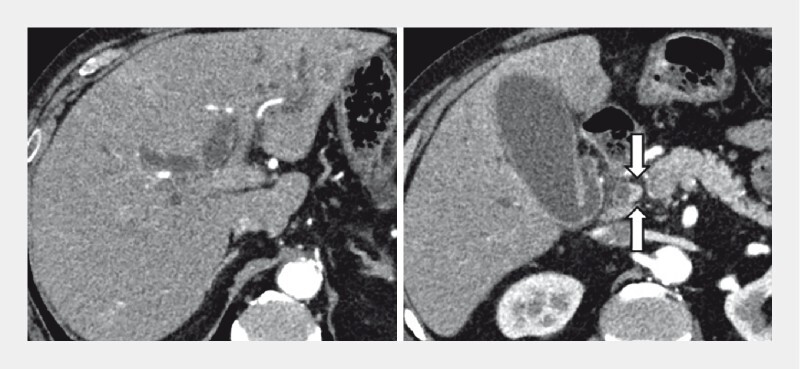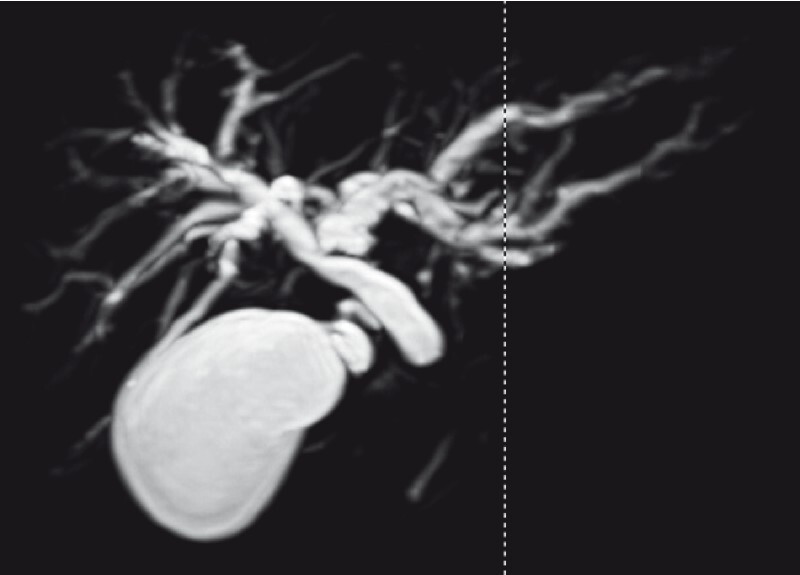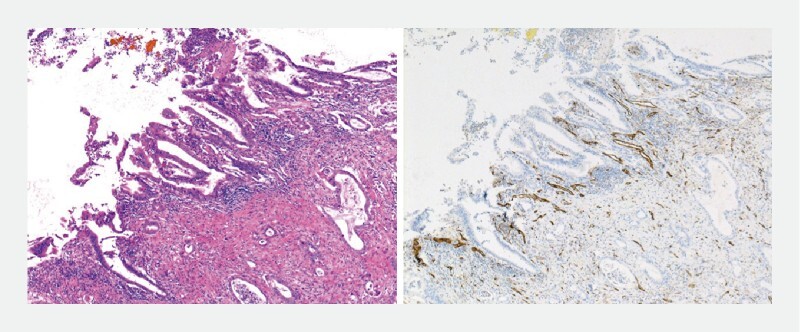Texture and color enhancement imaging (TXI) and red dichromatic imaging (RDI) modes are new image-enhancement systems available on the EVIS X1 (Olympus, Tokyo, Japan). TXI emphasizes slight differences in color tone and structural changes on the mucosal surface under normal-light observation and is expected to improve the observation performance of lesions 1 . On the other hand, RDI emphasizes the contrast of deep tissue and is expected to improve the visibility of deep blood vessels 2 . Especially in RDI mode 3, the color of bile disappears, making visualization easier. TXI and RDI modes are gaining popularity in the diagnosis of gastrointestinal cancer. However, TXI and RDI mode cholangioscopy (CHF-B290, Olympus) has not been reported for cholangiocarcinoma 3 . We describe the findings and characteristics of TXI mode 1 and RDI mode 3 cholangioscopy for cholangiocarcinoma.
An 81-year-old man was admitted to the hospital with obstructive jaundice and cholangitis ( Fig. 1 , Fig. 2 ). Endoscopic retrograde cholangiopancreatography was performed, revealing stenosis of the distal bile duct. A biliary stent was placed, cholangitis was treated, and histopathology revealed a cholangiocarcinoma. Cholangioscopy was performed to confirm the extent of superficial spreading. TXI mode 1 more clearly depicted the meandering tumor vessels along with caliber changes and the roughness of the tumor surface when compared to white-light imaging. In RDI mode 3, the color of bile disappeared and the tumor vessels were more accentuated than those in TXI ( Video 1 ). Narrow-band imaging demonstrated good delineation of superficial tumor vessels 4 , but the presence of bile made it difficult to observe the bile duct. Biopsies from the hilar region of the bile duct showed no malignancy, and a pancreatoduodenectomy was performed. Postoperative histopathology showed an irregular papillary epithelium with irregularly dilated tumor vessels ( Fig. 3 ). Image-enhanced cholangioscopy is useful in diagnosing cholangiocarcinomas.
Fig. 1.

Abdominal computed tomography shows contrast-enhancing wall thickening in the distal bile duct during the arterial phase (arrows).
Fig. 2.

Magnetic resonance cholangiopancreatography shows stenosis of the distal bile duct.
Fig. 3.

Postoperative pathology showed an irregular papillary epithelium with irregularly dilated tumor vessels (left: HE-stain, right: CD31 immunohistochemical stain).
Video 1 Demonstration of new image-enhanced cholangioscopy for the diagnosis of cholangiocarcinoma.
Endoscopy_UCTN_Code_CCL_1AZ_2AC
Footnotes
Competing interests The authors declare that they have no conflict of interest.
Endoscopy E-Videos : https://eref.thieme.de/e-videos .
Endoscopy E-Videos is an open access online section, reporting on interesting cases and new techniques in gastroenterological endoscopy. All papers include a high quality video and all contributions are freely accessible online. Processing charges apply (currently EUR 375), discounts and wavers acc. to HINARI are available. This section has its own submission website at https://mc.manuscriptcentral.com/e-videos
References
- 1.Sato T. TXI: Texture and color enhancement imaging for endoscopic image enhancement. J Healthc Eng. 2021;2021:5.518948E6. doi: 10.1155/2021/5518948. [DOI] [PMC free article] [PubMed] [Google Scholar]
- 2.Miyamoto S, Sugiura R, Abiko S et al. Red dichromatic imaging helps in detecting exposed blood vessels in gastric ulcer induced by endoscopic submucosal dissection. Endoscopy. 2021;53:E403–E404. doi: 10.1055/a-1314-9714. [DOI] [PubMed] [Google Scholar]
- 3.ASGE Technology Committee . Komanduri S, Thosani N et al. Cholangiopancreatoscopy. Gastrointest Endosc. 2016;84:209–221. doi: 10.1016/j.gie.2016.03.013. [DOI] [PubMed] [Google Scholar]
- 4.Igarashi Y, Okano N, Ito K et al. Endoscopic observation of mucosal spread lesion of cholangiocarcinoma using peroral cholangioscopy with narrow band imaging. Dig Endosc. 2007;19:S109–S114. doi: 10.1111/j.1443-1661.2007.00707.x. [DOI] [Google Scholar]


